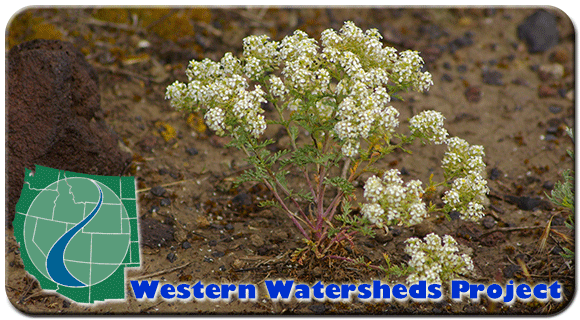August 16, 2016
Online Messenger #336
Western Watersheds Project applauds yesterday’s announcement from the U.S. Fish and Wildlife that the slickspot peppergrass (Lepidium pappilliferum) will remain protected as “Threatened” under the Endangered Species Act! This is a species that WWP has been working on for over a decade.
Political meddling from the livestock industry and its friends in the state of Idaho kept this plant from being protected under the ESA. Three times, WWP had to challenge in court the Fish and Wildlife Service’s failure to protect the plant. And three times, thanks to our attorneys at Advocates for the West, courts overturned the agency’s failure to protect it. This new determination that the species remains warranted is welcome news, despite the bad news that the plant remains so troublingly imperiled.
Slickspot peppergrass is a fascinating desert plant that displays two different life cycles, an annual and a biennial form. It is endemic to a narrow band across southwestern Idaho, where it occurs only in “slickspots” or wet areas in the desert. Only 100 occurrences of the plant are known. The primary land use on its public lands habitat is livestock grazing. Cattle naturally congregate in the wet spots, trampling the plants and its habitat. This trampling, combined with weed invasions and increased fires—both of which are worsened by cattle grazing—have left the plant in dire straits. As one scientist put it, the plant is “at a tipping point in terms of its prospect for survival.”
The livestock industry in Idaho maintains an outsized hoofprint, the new rule protecting the plant fails to consider livestock grazing a significant threat to the species. The Service lists invasive species and wildfires as dominant causes for concern, failing to recognize head-on that livestock grazing and its pervasive negative influence on arid ecosystems increases invasive species infestations and, in turn, fuels the unnatural fire cycles that harm Idaho’s high desert landscape.
The Service also identified Owyhee harvester ants’ impact on the seedbank of the plant as an emerging threat in light of the habitat conversion underway in most of its habitat. It’s telling that the Service can talk about the effect of ants but not the sacred cows that trample and degrade slickspot habitat.
The land management agencies are going to have to come up with a better plan for keeping livestock off of grazing allotments where slickspot occurs or the plant is doomed. With the new rule and a pending critical habitat designation, WWP will continue to press for effective management on our public lands.







